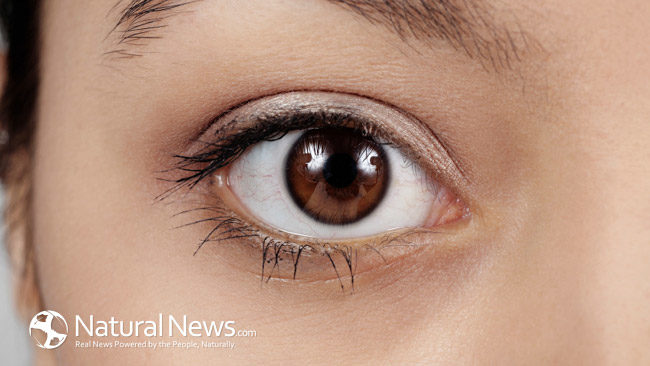Statistics show that 150 million Americans are wearing contact lenses or glasses to correct refractive errors like nearsightedness or farsightedness. As people age, they may develop other difficult to manage diseases of the eye, like cataracts, macular degeneration and glaucoma. Even if you don’t have any eye problems yet, research has consistently shown that vision can be protected naturally, through a combination of healthy lifestyle choices and non-invasive therapy.
Vitamins for healthy eyes
The exclusion of certain nutrients from one’s daily diet can have a devastating long term effect on eye health, leading to a progressive loss of vision, and eventually, blindness.
Vitamins C and E are powerful antioxidants that can help protect the frail structures of the eye against oxidative damage. Lutein and zeaxanthin, on the other hand, are used in the macula of the eye, which is located at the center of the retina, and is responsible for absorbing UV rays and blue light. 2 parts of macula, called the fovea and foveola, are needed for high acuity vision.
Antioxidants provide most benefits to vision when consumed in combination with other antioxidants. A study that was featured in the journal Ophthalmology shows that vitamins C and E on their own do not provide protection against macular degeneration. Instead, they only help protect against age related eye diseases when combined with other nutrients, like lutein, zeaxanthin, carotenoids and zinc.
Julia Mares, a professor of Ophthalmology at the University of Wisconsin, explained that eye healthy nutrients are best obtained from wholesome foods rather than eye health supplements, and that the people with the healthiest eyes are those who consumed a natural, nutrient dense diet.
Do carrots help your eyesight – food for healthy eyes
Carrots are rich in fibre, minerals and antioxidants, but also in betacarotene, a plant pigment that is metabolized into vitamin A. This vitamin is then used by the retina of the eye in the form of retinal, which absorbs light and boosts low-light vision clarity.
Green leafy vegetables, zucchini, pistachios, goji berries, kiwifruit and eggs are rich in lutein and zeaxanthin, while bell peppers, citrus fruits, Kakadu plums, blackcurrant, and guava have the highest concentrations of vitamin C. Pumpkin seeds, sunflower seeds, avocados, asparagus, walnuts and almonds are rich in both zinc and vitamin E. Of these, green leafy vegetables are arguable some of the best foods for eye health.
Video: How to improve eye health – eating the right foods
Pinhole glasses – do they work?
Pin hole glasses (watch this video – *aff link) are special eyeglasses that have two plastic sheets filled with pinhole-sized perforations instead of lenses. The principle behind pinhole glasses is that each tiny hole allows only a thread of light to enter the eye, dramatically increasing depth of field for eyes suffering from refractive errors. The “pinhole effect” is also used in ophthalmology for diagnosis purposes.
Proponents of the use of pinhole glasses claim (*aff link) that they can permanently improve eyesight just by wearing them for up to 20 minutes each day. Unfortunately, no scientific evidence has emerged to support that claim, but while they are being worn, it is clear that pinhole glasses do in fact help nearsighted and farsighted individuals focus better.
Symptoms of macular degeneration
Macular degeneration is an age related medical condition caused by the degradation of the macula, and it is also one of the most widespread causes of blindness in individuals aged 50 and older.
Symptoms of macular degeneration include pigmentary alterations, decreased visual acuity, blurred vision, distorted vision, loss of contrast sensibility, the inability to properly discern colors, hypersensitivity to light, poor low-light vision, and a range of other changes to central vision (potentially including visual artifacts and hallucinations of geometric shapes).
Computer monitor eye strain symptoms – computer vision syndrome
Computer vision syndrome occurs when the eyes are focused on a computer screen for extended periods of time, and is caused by stress to the tiny ciliary muscles of the eye. People with computer monitor eye strain will often experience headaches, blurred vision, dry eyes, double vision, and difficulty focusing.
The best solution to this problem is ensuring periodic, adequate rest for the eyes. A simple eye exercise meant to relieve stress symptoms is the “20-20-20 rule,” which involves taking a break every 20 minutes to look at an object located 20 feet away, for 20 seconds. Closing one’s eyes for at least 20 seconds every hour also helps to both rest the eyes and replenish the protective tear film that covers them.
Sources for this article include:
http://www.independent.co.uk/life-style/health-and-families/health-news/the-truth-about-pinhole-glasses-1253113.html
http://articles.chicagotribune.com/2012-05-30/health/sc-health-0530-eyesight-supplements-20120530_1_age-related-eye-disease-study-antioxidant-vitamins-beta-carotene-and-zinc
http://en.wikipedia.org/wiki/Computer_vision_syndrome
http://www.mayoclinic.com/health/macular-degeneration/DS00284/DSECTION=symptoms
* Affiliate link – I may end up getting a commission based on your purchases





